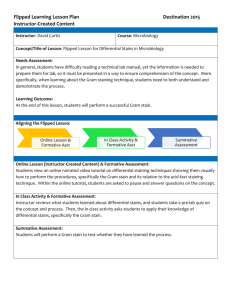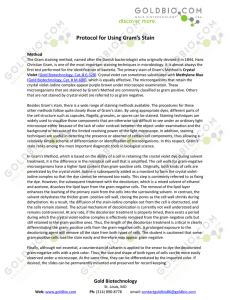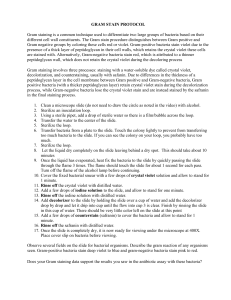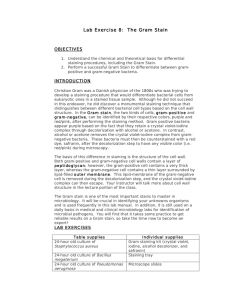Crystal Violet (1%) - Thermo Fisher Scientific
advertisement
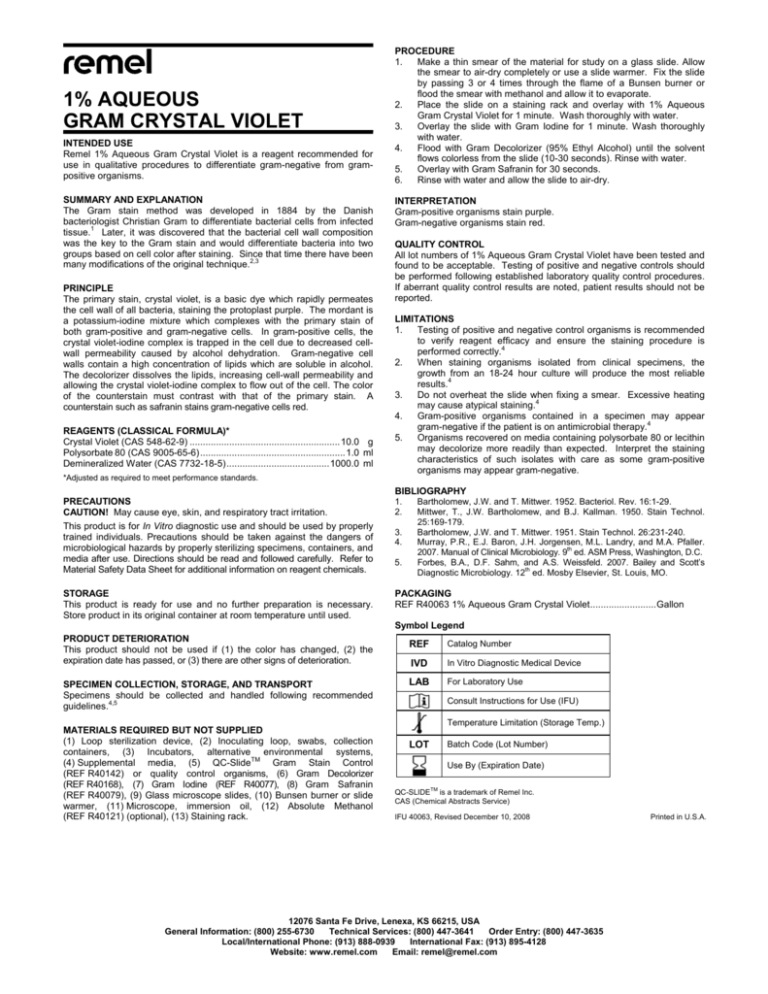
1% AQUEOUS GRAM CRYSTAL VIOLET INTENDED USE Remel 1% Aqueous Gram Crystal Violet is a reagent recommended for use in qualitative procedures to differentiate gram-negative from grampositive organisms. SUMMARY AND EXPLANATION The Gram stain method was developed in 1884 by the Danish bacteriologist Christian Gram to differentiate bacterial cells from infected tissue.1 Later, it was discovered that the bacterial cell wall composition was the key to the Gram stain and would differentiate bacteria into two groups based on cell color after staining. Since that time there have been many modifications of the original technique.2,3 PRINCIPLE The primary stain, crystal violet, is a basic dye which rapidly permeates the cell wall of all bacteria, staining the protoplast purple. The mordant is a potassium-iodine mixture which complexes with the primary stain of both gram-positive and gram-negative cells. In gram-positive cells, the crystal violet-iodine complex is trapped in the cell due to decreased cellwall permeability caused by alcohol dehydration. Gram-negative cell walls contain a high concentration of lipids which are soluble in alcohol. The decolorizer dissolves the lipids, increasing cell-wall permeability and allowing the crystal violet-iodine complex to flow out of the cell. The color of the counterstain must contrast with that of the primary stain. A counterstain such as safranin stains gram-negative cells red. REAGENTS (CLASSICAL FORMULA)* Crystal Violet (CAS 548-62-9) .........................................................10.0 g Polysorbate 80 (CAS 9005-65-6).......................................................1.0 ml Demineralized Water (CAS 7732-18-5).......................................1000.0 ml *Adjusted as required to meet performance standards. PROCEDURE 1. Make a thin smear of the material for study on a glass slide. Allow the smear to air-dry completely or use a slide warmer. Fix the slide by passing 3 or 4 times through the flame of a Bunsen burner or flood the smear with methanol and allow it to evaporate. 2. Place the slide on a staining rack and overlay with 1% Aqueous Gram Crystal Violet for 1 minute. Wash thoroughly with water. 3. Overlay the slide with Gram Iodine for 1 minute. Wash thoroughly with water. 4. Flood with Gram Decolorizer (95% Ethyl Alcohol) until the solvent flows colorless from the slide (10-30 seconds). Rinse with water. 5. Overlay with Gram Safranin for 30 seconds. 6. Rinse with water and allow the slide to air-dry. INTERPRETATION Gram-positive organisms stain purple. Gram-negative organisms stain red. QUALITY CONTROL All lot numbers of 1% Aqueous Gram Crystal Violet have been tested and found to be acceptable. Testing of positive and negative controls should be performed following established laboratory quality control procedures. If aberrant quality control results are noted, patient results should not be reported. LIMITATIONS 1. Testing of positive and negative control organisms is recommended to verify reagent efficacy and ensure the staining procedure is performed correctly.4 2. When staining organisms isolated from clinical specimens, the growth from an 18-24 hour culture will produce the most reliable results.4 3. Do not overheat the slide when fixing a smear. Excessive heating may cause atypical staining.4 4. Gram-positive organisms contained in a specimen may appear gram-negative if the patient is on antimicrobial therapy.4 5. Organisms recovered on media containing polysorbate 80 or lecithin may decolorize more readily than expected. Interpret the staining characteristics of such isolates with care as some gram-positive organisms may appear gram-negative. BIBLIOGRAPHY PRECAUTIONS CAUTION! May cause eye, skin, and respiratory tract irritation. This product is for In Vitro diagnostic use and should be used by properly trained individuals. Precautions should be taken against the dangers of microbiological hazards by properly sterilizing specimens, containers, and media after use. Directions should be read and followed carefully. Refer to Material Safety Data Sheet for additional information on reagent chemicals. STORAGE This product is ready for use and no further preparation is necessary. Store product in its original container at room temperature until used. 1. 2. 3. 4. 5. Bartholomew, J.W. and T. Mittwer. 1952. Bacteriol. Rev. 16:1-29. Mittwer, T., J.W. Bartholomew, and B.J. Kallman. 1950. Stain Technol. 25:169-179. Bartholomew, J.W. and T. Mittwer. 1951. Stain Technol. 26:231-240. Murray, P.R., E.J. Baron, J.H. Jorgensen, M.L. Landry, and M.A. Pfaller. 2007. Manual of Clinical Microbiology. 9th ed. ASM Press, Washington, D.C. Forbes, B.A., D.F. Sahm, and A.S. Weissfeld. 2007. Bailey and Scott’s Diagnostic Microbiology. 12th ed. Mosby Elsevier, St. Louis, MO. PACKAGING REF R40063 1% Aqueous Gram Crystal Violet.........................Gallon Symbol Legend PRODUCT DETERIORATION This product should not be used if (1) the color has changed, (2) the expiration date has passed, or (3) there are other signs of deterioration. SPECIMEN COLLECTION, STORAGE, AND TRANSPORT Specimens should be collected and handled following recommended guidelines.4,5 MATERIALS REQUIRED BUT NOT SUPPLIED (1) Loop sterilization device, (2) Inoculating loop, swabs, collection containers, (3) Incubators, alternative environmental systems, (4) Supplemental media, (5) QC-SlideTM Gram Stain Control (REF R40142) or quality control organisms, (6) Gram Decolorizer (REF R40168), (7) Gram Iodine (REF R40077), (8) Gram Safranin (REF R40079), (9) Glass microscope slides, (10) Bunsen burner or slide warmer, (11) Microscope, immersion oil, (12) Absolute Methanol (REF R40121) (optional), (13) Staining rack. REF Catalog Number IVD In Vitro Diagnostic Medical Device LAB For Laboratory Use Consult Instructions for Use (IFU) Temperature Limitation (Storage Temp.) LOT Batch Code (Lot Number) Use By (Expiration Date) QC-SLIDETM is a trademark of Remel Inc. CAS (Chemical Abstracts Service) IFU 40063, Revised December 10, 2008 12076 Santa Fe Drive, Lenexa, KS 66215, USA General Information: (800) 255-6730 Technical Services: (800) 447-3641 Order Entry: (800) 447-3635 Local/International Phone: (913) 888-0939 International Fax: (913) 895-4128 Website: www.remel.com Email: remel@remel.com Printed in U.S.A.



